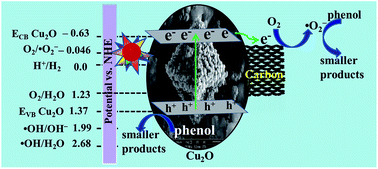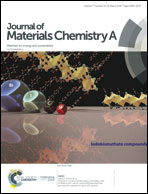A highly stable metal–organic framework derived phosphorus doped carbon/Cu2O structure for efficient photocatalytic phenol degradation and hydrogen production†
Abstract
Developing a low cost but efficient photocatalyst with maximum utilization of sunlight, minimum charge carrier recombination and improved stability is very crucial and challenging. Triphenylphosphine modification of HKUST-1 followed by controlled calcination resulted in a phosphorus doped carbon/Cu2O composite (HKUST-1-P-300). The structure and band properties were fully studied, and phenol degradation and H2 evolution were employed to evaluate the photocatalytic activity. Under visible light irradiation, HKUST-1-P-300 showed superior photocatalytic activity and stability. A phenol degradation efficiency of up to 99.8% was achieved within 90 minutes, and also a remarkable H2 evolution rate of 1208 μmol was achieved. The external quantum efficiency of solar hydrogen evolution over this photocatalyst, without noble metal loading, reaches 48.6% at 425 nm. More auspiciously, the photocatalytic reaction continued for more than 12 h without performance degradation. To get further evidence for the origin of the improved photocatalytic activity of the HKUST-1-P-300, a series of characterization studies have been carried out. To the best of our knowledge, this work represents the first example of using P-doped carbon/Cu2O both for phenol degradation and H2 production. Mechanistic studies were carried out to give insights into the photodegradation process, and the superior photocatalytic activity of HKUST-1-P-300 can be ascribed to enhanced visible light absorption efficiency, higher surface area, efficient separation of photogenerated charge carriers, reduced aggregation of Cu2O and the synergistic effect of the P-doped carbon/Cu2O structures. This work demonstrates a facile and promising approach for designing low cost, highly stable and efficient heterostructured photocatalysts that can be applicable for energy and environmental applications.



 Please wait while we load your content...
Please wait while we load your content...